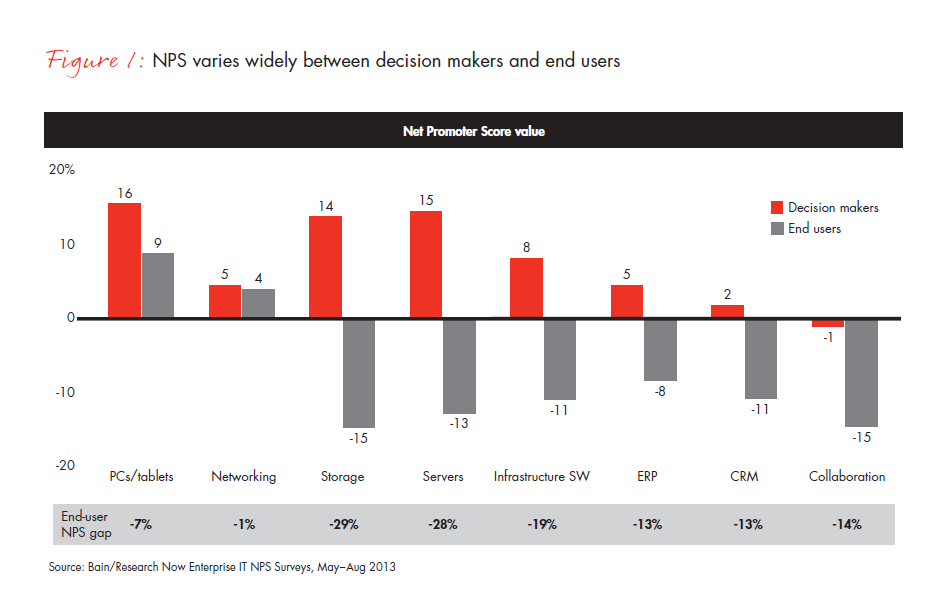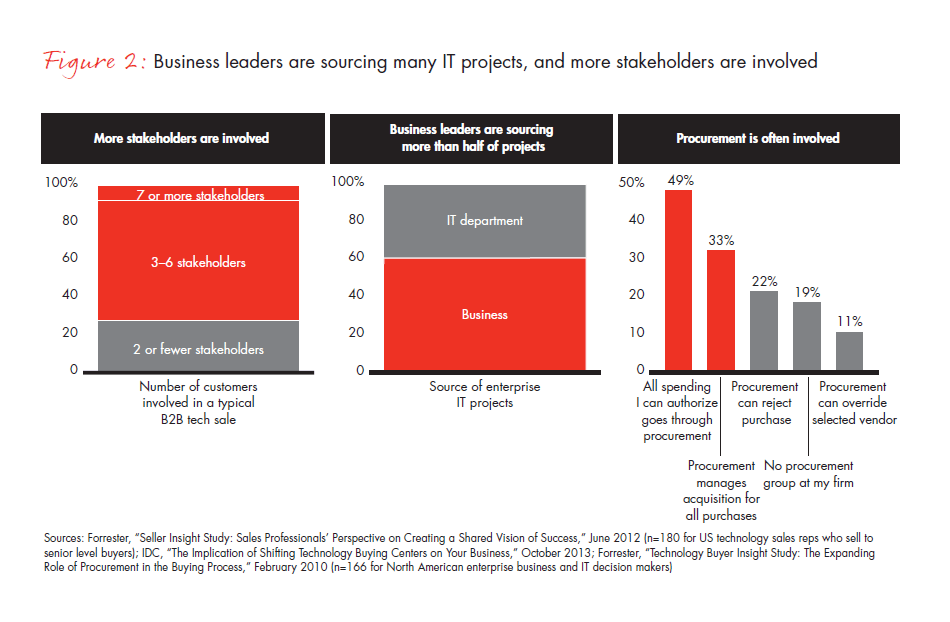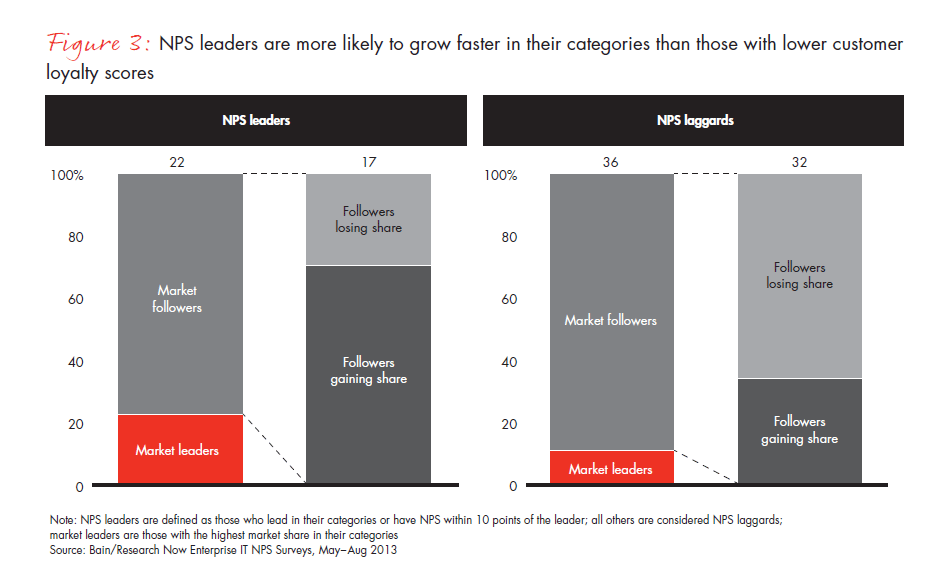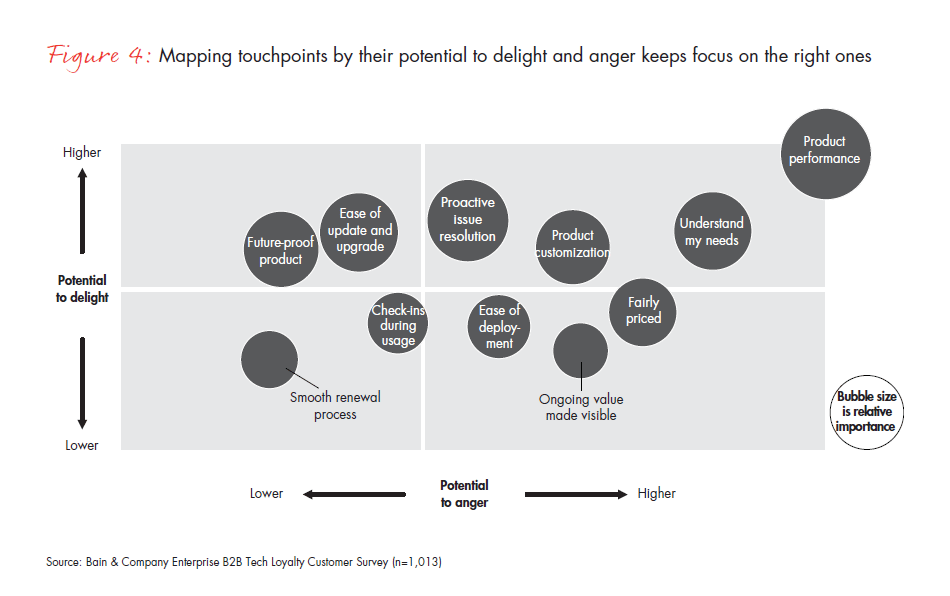Brief
It’s not exactly a trade secret: Enterprise IT companies are not typically known for delivering breakthrough customer experiences. Their customer experience scores (using the Net Promoter ScoreSM, or NPS®, as the metric) are low, down in a range with the health insurance industry—not terribly aspirational.
Until recently, many tech companies have been able to get by and thrive without emphasizing customer experience. Often they could lock in long-term contracts with buyers who didn’t share the negative opinions end users in the buyers’ organization had of them. And, as in the health insurance industry, buyers often had relatively poor visibility into pricing and competitive options.
But the industry is changing rapidly, and end-to-end customer experience—which includes how easy it is for customers to learn the product, how the product performs and how the vendor responds to customers’ issues— matters more than ever in enterprise IT. The shift toward cloud computing, changes in the customer buying process and the maturation of the tech industry are all giving customers more leverage in technology purchasing decisions.
To better understand the evolving role of customer experience in enterprise IT, Bain, in collaboration with market research firm Research Now, surveyed decision makers and end users of eight different hardware and software categories in the US, gathering about 700 respondents for each category.1 As in all NPS surveys, one central question we wanted to understand was, “How likely are you to recommend your enterprise IT vendor to a friend or colleague?”
We found not only low scores for end users, but also a massive gap between their perceptions and those of decision makers. In six of the eight categories, end users gave a negative NPS—that is, they were more likely to be detractors than promoters of their tech vendor. Meanwhile, the scores for decision makers were negative for only one category (see Figure 1).

Why the discrepancy? Often tech vendors have overpromised to decision makers to win the sale and then under-delivered. In our survey, end users cited frustrations with the availability and competence of customer support for hardware; for software, users cited long and complex installations, poor integration and generally clunky functionality and interfaces.
How the enterprise IT model is changing
In general, enterprise tech vendors have focused heavily on sales and marketing and product development over the actual customer experience. The old model for enterprise software and hardware depended on a higher-cost direct sales effort that focused relentlessly on key customer decision makers rather than on end users. Vendors often sold a vision of the product’s future possibilities rather than the reality of the day-one experience, and they charged a substantial amount upfront for the product. Once a buyer had decided on a vendor, it was difficult to switch, even if the actual customer experience after installation was poor.
But as most executives know, the environment in which that sales-and-marketing-driven model developed is changing. Until recently, vendors could focus their sales efforts on a limited set of buyers—in most cases, the CIO and senior IT executives. Now executives in the non-technical functions and in procurement are much more heavily involved in the purchasing process. Armed with increasingly transparent information about pricing, experience and value, buyers across the board are more sophisticated. This has led to more rigorous procurement processes and the decline of “golf course” deal closure (see Figure 2).

Moreover, as the tech market matures, the pathway to profitable growth shifts from attracting new customers to retaining, upselling and cross-selling existing customers. This requires attention to customer touch points after the initial sale, where end users have a stronger voice. Lastly, as pricing models and tech margins shift from products to services, it’s increasingly difficult to sustain poor customer experience when much of the value of the contract has yet to be paid. As an executive at one software-as- a-service (SaaS) provider told us, “We are no longer in an upfront license business, we are now in a renewals business. This software business model can no longer afford poor customer experience.” This is true not only for SaaS. In hardware, too, support and maintenance contracts, along with renewals, are critical elements of the customer lifetime value.
James Dixon, a partner in Bain's Technology, Media and Telecom practices, explains how companies need to make customer experience a priority as more products and services move to the cloud.
Customer experience matters in enterprise IT
Our research shows that customer experience influences growth for tech companies. Promoters are two to three times more likely than detractors to renew with their vendor. Renewal rates of products with low NPS can run 10 or more points below similar products with higher NPS values— differences that amount to hundreds of millions of dollars.
At many enterprise software companies, it’s not unusual for renewals on older versions of products to run lower than newer versions, sometimes by as much as 50%. Savvy competitors often target those customers to gain share. Incumbents need to respond very aggressively with upgrade programs to stem attrition.
Our surveys also found that promoters are about twice as likely as detractors to consider using other products from the same vendor. We have seen this play out in our client experience as well. Efforts to overhaul the customer experience for an enterprise IT client’s core product not only spurred sales for the core product but also reignited growth for adjacent products.
Finally, we found a relationship between customer advocacy and industry leadership. We segmented each category’s vendors into NPS leaders and laggards, and compared the financial performance of vendors in each group. Vendors with a higher NPS were twice as likely as laggards to be market leaders. And among those who are not market leaders, about 70% of NPS leaders are gaining share, while only about one-third of laggards are gaining share (see Figure 3). Of course, there are always outliers: In some categories, legacy leadership and customer lock-in allow some companies with poor customer loyalty scores to sustain market leadership. However, the structural changes under way, such as shifts to services and greater transparency, suggest these advantages may not last.

How to build better customer experience capabilities
- Know your customers. Find out which touchpoints matter most in driving delight and frustration among your customers (see Figure 4). Benchmark yourself against direct competitors and loyalty leaders in your sector, and invest in addressing the most critical elements of customer experience for customers at greatest risk of leaving.
- Put it in context. Set goals for customer experience that align with your competitive situation and your critical strategic issues. A customer experience transformation for a company looking to boost renewal rates may look quite different from one for a company looking to extend its reach to an adjacent product category.
- Create an “insights to action” engine. Leaders make programmatic investments to track and continuously improve customer loyalty. A well-designed customer experience system has a closed feedback loop installed in each priority touchpoint—one that engages customers, fixes their issues and filters lessons learned back to the organization.
- Change the mindset. Instill a business culture and create systems based on customer experience. IT companies that have given lip service to customer experience will find it difficult to meaningfully improve with an “initiative of the month” approach. A cultural reset around the customer is needed— both top-down and bottom-up. Installing a chief customer officer helps but is not enough.
- Be patient: Recognize that it’s a long journey. Commit to bringing your customer experience in line with your promises.

Where are you in your customer experience journey?
Three questions can help executives begin to turn a critical eye toward their company’s approach to customer loyalty.
- Who owns customer experience?
- Are there specific organizational investments at senior levels?
- Is customer experience a central part of the operating model across the organization— not just in customer-facing roles?
- Do you know which elements of your customers’ experience have the greatest impact on their advocacy?
- What are you doing to continually improve customer experience?
- How do you measure your progress?
- What is the feedback loop to your strategic plans and day-to-day management?
Chris Brahm is a partner in Bain & Company’s San Francisco office. James Dixon is a partner in Bain’s Silicon Valley office, where Sarah O’Brien is a manager. Amir Nahai is a partner working in Bain’s Paris and Los Angeles offices. All four work with Bain’s Global Technology practice.



